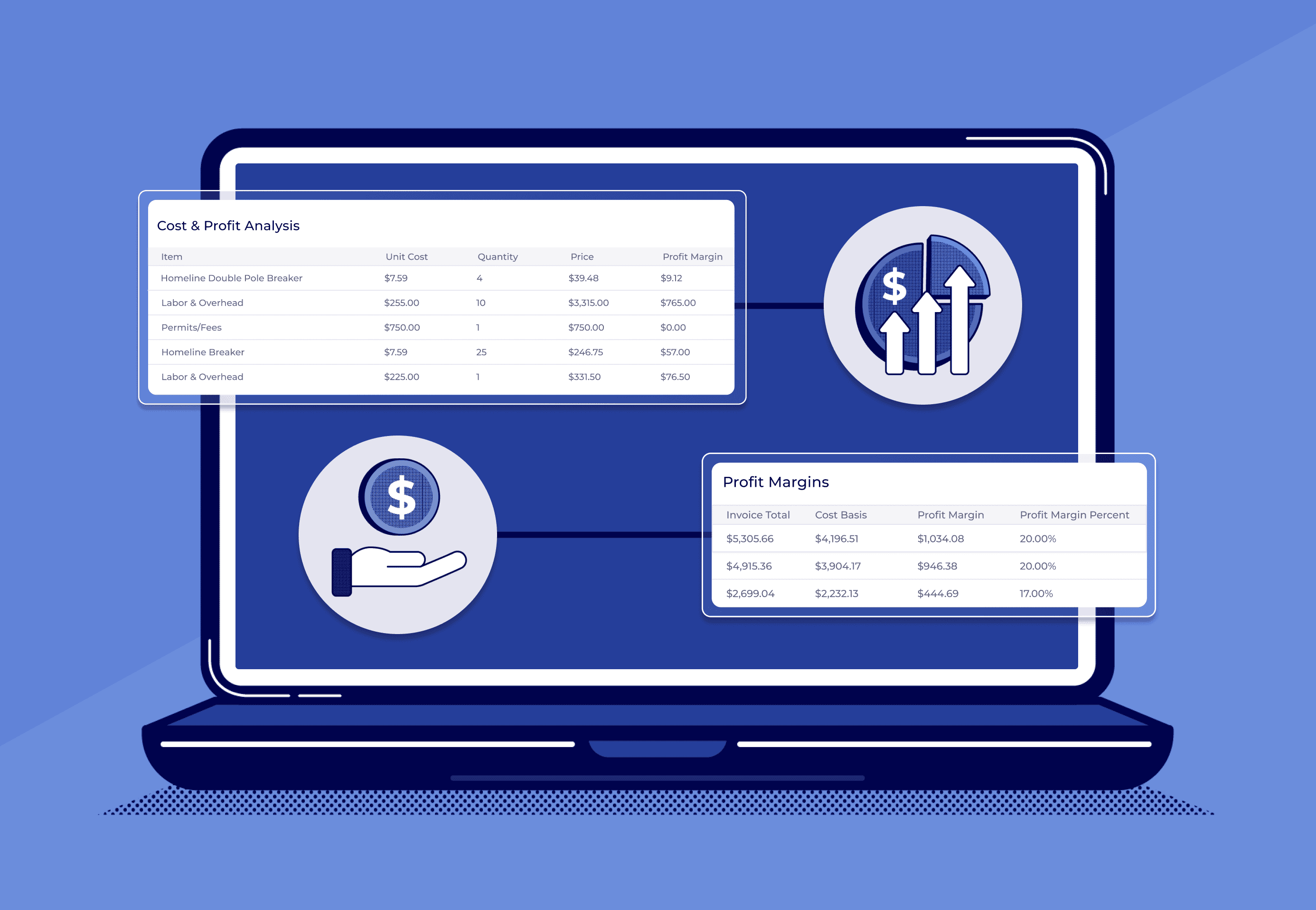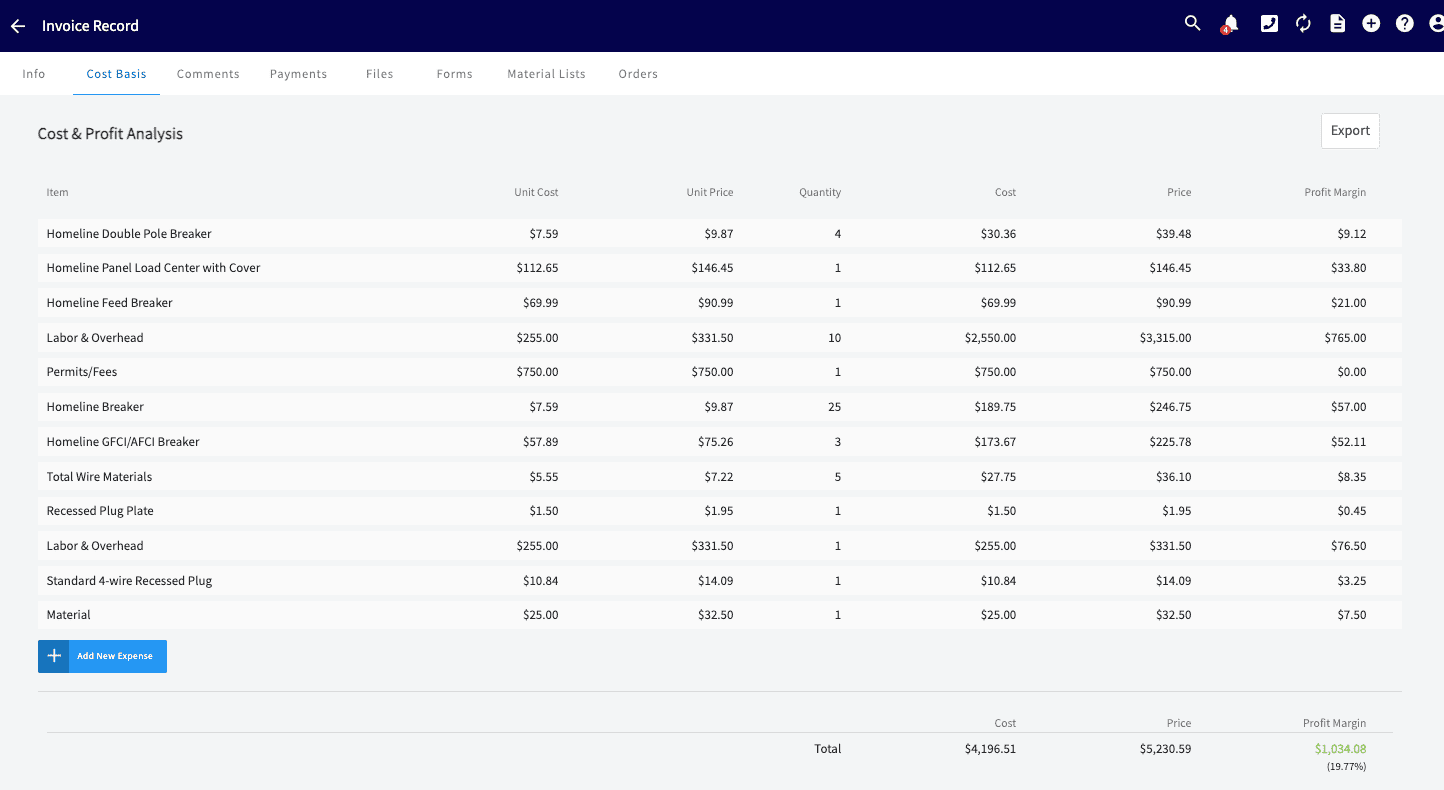Gross Profit Margin vs. Net Profit Margin: What Field Service Businesses Need to Know
Master the gross profit margin formula with our step-by-step guide. Learn to calculate and analyze your business's profitability effectively. Read more!
May 19, 2025

Running a successful field service business—whether it’s HVAC, plumbing, electrical, or general contracting—means keeping a tight handle on your numbers. You know you’re bringing in revenue. But how much of that company's revenue is actually sticking around as profit after all your expenses are paid?
That’s where understanding profit margins comes in.
In this guide, we’ll break down the difference between gross and net profit margin , show you how to calculate both using real-world field service examples, and explain why tracking your margins can make or break your business. We’ll also show how tools like FieldPulse can simplify profit tracking across every job, helping you make better decisions and uncover hidden opportunities.
Introduction to Profit Margins
Profit margins are a crucial metric for businesses to measure their financial performance and profitability. They provide insight into how much of the revenue generated by a business is retained as profit after accounting for various costs. There are several types of profit margins, including gross profit margin, operating profit margin, and net profit margin, each offering a different perspective on a company’s financial health.
Gross profit margin focuses on the profitability of a company’s core operations by looking at the revenue left after subtracting the cost of goods sold (COGS). This margin helps field service businesses understand how efficiently they are producing and pricing their services.
Operating profit margin goes a step further by considering operating expenses in addition to COGS. This margin provides insight into a company’s operational efficiency and its ability to manage day-to-day expenses.
Net profit margin is the most comprehensive, taking into account all expenses, including operating costs, taxes, and interest. It shows the percentage of revenue that remains as net profit, offering a clear picture of overall profitability.
A high profit margin indicates a service company’s ability to effectively control its costs and/or provide services at a price significantly higher than its costs. Conversely, a low profit margin may signal an ineffective cost structure or poor pricing strategies. Understanding these margins is essential for businesses to make informed decisions about pricing, cost management, and investment strategies.
In this section, we will delve into the different types of profit margins, their calculations, and their importance in evaluating a company’s financial health.
What Is Profit Margin?
At its simplest, profit margin is a measure of how much money your business actually keeps from the sales revenue it brings in.
It’s expressed as a percentage and helps answer questions like:
- Are we charging enough?
- Are we spending too much on materials or labor?
- Are our jobs as profitable as they seem?
There are two main types of profit margins you should care about:
- Gross Profit Margin
- Net Profit Margin
Let's break down each one.
Gross Profit Margin: The First Layer of Profitability
Definition
Gross profit margin looks at how much money is left after you subtract the direct costs, including material costs and labor, from the revenue you earned.
Gross Profit Margin Formula
- Revenue: What you charge the customer.
- COGS: The materials and labor directly tied to the job.
Field Service Example: Plumbing Job
- Revenue: $1,200
- Materials: $250
- Labor: $400
COGS = $250 (materials) + $400 (labor) = $650
Gross Profit = $1,200 - $650 = $550
Gross Profit Margin = ($550 / $1,200) × 100 = 45.8%
This tells you that 45.8% of your revenue remains after covering the cost of doing the job. Not bad, but it doesn’t show the full picture.
Net Profit Margin: The Bottom Line
Definition
Net profit margin takes things further by subtracting all expenses from your revenue—not just direct costs, but also things like rent, admin salaries, fuel, tools, insurance, marketing, higher interest expenses, and other overhead.
How To: Calculate Net Profit Margin Formula
Net Profit Margin Calculation = (Net Profit / Revenue) × 100
Where:
- Net Profit = Revenue - COGS - Operating Expenses - Taxes - Interest
Continuing the Plumbing Job Example
Let’s say:
- Gross Profit = $550 (from earlier)
- Monthly truck lease: $100
- Office overhead allocation: $75
- Insurance: $25
- Misc. expenses: $50
Total Additional Expenses = $250
Net Profit = $550 - $250 = $300
Net Profit Margin = ($300 / $1,200) × 100 = 25%
Now we’re seeing the true profitability after all costs are accounted for.
Income Statement Analysis
The income statement is a critical financial document that provides insight into a company’s revenue, expenses, and profitability. Analyzing the income statement is essential for understanding a company’s profit margins and identifying areas for improvement.
The income statement typically includes line items such as revenue, cost of goods sold (COGS), operating expenses, interest expense, and net income. By analyzing these line items, businesses can calculate their gross profit margin, operating profit margin, and net profit margin.
For instance, the gross profit margin is calculated by subtracting COGS from revenue and then dividing by revenue. This margin helps businesses understand how much profit they are making from their core operations before accounting for other expenses.
The operating profit margin is determined by subtracting operating expenses from gross profit and then dividing by revenue. This margin provides insight into how well a company is managing its operating costs.
The net profit margin is calculated by subtracting all expenses, including taxes and interest, from total revenue and then dividing by revenue. This margin offers a comprehensive view of a company’s overall profitability.
A company’s income statement can also be used to compare its financial performance over time and against industry averages. This comparison helps businesses identify trends and patterns in their revenue and expenses, which can inform their strategic decisions.
By using the income statement to calculate profit margins and analyze financial performance, businesses can make informed decisions about their operations, investments, and growth strategies. Understanding these financial metrics is crucial for maintaining a company’s financial health and ensuring long-term success.
Why Does Understanding Profit Margins Matter?
Knowing your gross and net profit margins isn’t just good accounting hygiene—it’s a strategic advantage for assessing your company's financial health. Here’s why.
1. Spot Underperforming Jobs or Crews
Tracking margins on a job-by-job basis helps you identify:
- Teams that regularly go over labor estimates
- Jobs that require more materials than expected
- Services with razor-thin margins that may not be worth offering
2. Set Better Prices
Understanding your costs and margins helps you price confidently and competitively . You’ll avoid underbidding just to win work—and make sure you’re not leaving money on the table.
3. Make Smarter Hiring and Equipment Decisions
Let’s say your net profit margins are dipping. Is it time to hire more techs or invest in better tools to increase efficiency? Or are you overextended and need to tighten costs?
Margins offer a data-backed way to answer these questions.
4. Plan for Growth and Investment
Banks, investors, or even potential buyers will look closely at your profit margins. Healthy margins show your business is efficient, scalable, and worth backing.
Unique Reasons Field Service Businesses Need Margin Visibility
Beyond the standard reasons, here are some field-service-specific situations where margin tracking is critical:
1. Managing Seasonal Swings
Many field service businesses face high seasonality. Profit margin trends and cash flow analysis help you prepare for lean months, budget for ramp-up periods, and avoid overstaffing during slow seasons.
2. Tracking Project-Based Profitability
Large install jobs (e.g., HVAC system replacements, solar panel installations) span days or weeks and have different cost structures than routine maintenance. Gross and net margin tracking per project helps you assess whether these high-revenue jobs are truly high-margin by indicating how much profit a business generates from its total revenue.
3. Evaluating Service Packages or Memberships
Do your preventative maintenance plans actually improve profitability? Are your bundled service packages delivering value? Profit margin analysis helps quantify their impact.
4. Making Dispatching Decisions
If Job A is 20 miles away with a slim margin and Job B is close by and more profitable, your dispatcher can make a smarter scheduling call.
Common Profit Margin Benchmarks in Field Service
While margins vary by industry and region, here are general guidelines to determine a good profit margin:
| Field Service Type | Average Gross Profit Margin | Average Net Profit Margin |
|---|---|---|
| HVAC | 40–60% | 10–20% |
| Plumbing | 40–55% | 8–15% |
| Electrical | 35–50% | 10–18% |
| General Contracting | 30–45% | 5–12% |
If your numbers fall short, it doesn’t necessarily mean your business is failing—but it does mean there’s room for improvement.
How to Improve Your Profit Margins
Here are a few strategic ways field service businesses can improve gross and net margins:
To Improve Gross Margin:
- Re-negotiate supplier pricing
- Use flat-rate pricing with built in buffer through the FieldPulse Pricebook
- Optimize job scoping to avoid costly surprises
To Improve Net Margin:
- Reduce travel time through smarter routing
- Go paperless to cut admin costs
- Bundle services to increase per-visit revenue
- Use subcontractors wisely to avoid full-time costs to increase profitability
How FieldPulse Helps You Track and Improve Profit Margins
Tracking profit margins across every job used to mean juggling spreadsheets and paper invoices. Not anymore .
FieldPulse, the highest rated field service software makes it simple to calculate, monitor, and analyze your gross and net profit margins —all within a single platform.
1. Profit Visibility by Job
Get clear visibility into how much each job actually makes you by referencing the Reports tab across jobs or using the reporting feature to configure jobs reports grouped by type, team member, and more. Track materials, labor, travel time, discounts, and overhead—all factored into each job’s margin.
2. Automatic Profit Margin Calculations

As soon as an estimate is created, FieldPulse automatically calculates:
- Gross profit margin - materials
- Gross profit margin - labor & service
If your business pays commission to estimators, FieldPulse also calculates commission based on percentage of gross sales, percentage of gross margin or flat rate, depending on your operations process .
3. Customizable Reports
Run job reports by:
- Customer
- Service Type
- Crew/Team
- Individual team member
- Region
This helps you spot trends like “Install jobs in the north region are 12% less profitable” or “Crew B consistently exceeds margin targets.”
4. Estimate Smarter, Close Stronger
Use historical job data to create more accurate estimates. Set margin goals and ensure every bid you send out hits your target profit range.
5. Integrations and Insights
FieldPulse integrates with QuickBooks Online and Quickbooks Desktop to pull real-time expense data, giving you a clear snapshot of profitability across the business.
Final Thoughts: Profit Margins as a Leadership Tool
Field service businesses are complex machines with many moving parts: people in the field, inventory, fuel, customer demands, and seasonal cycles. As a business owner or operations director, your job is to keep that machine running efficiently—and profitably.
Understanding the difference between gross and net profit margins, using the right formulas, and analyzing margins at a job and business level puts you in control. You’ll know where you’re winning, where you’re leaking cash, and where you can grow.
With FieldPulse, you don’t have to guess.
You get clear, actionable data that helps you turn jobs into reliable profit, with less guesswork and more confidence.
Ready to take control of your profit margins?
Try FieldPulse today and start making every job more profitable .
Ready to get started?
Book a FieldPulse demo today for a free product walkthrough with our team.